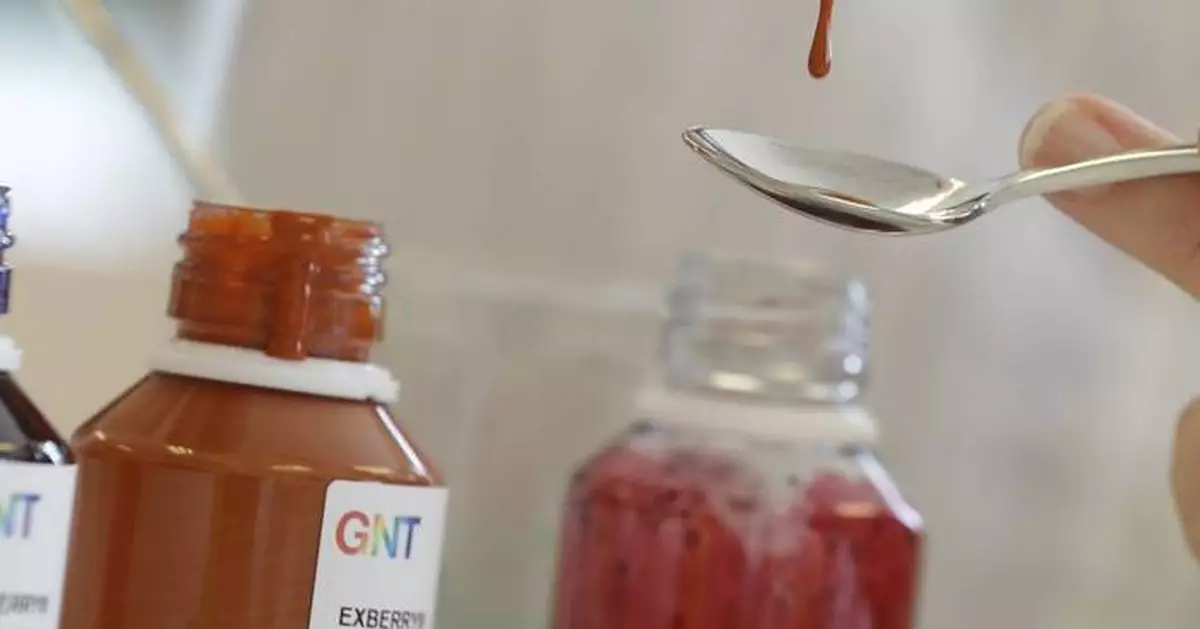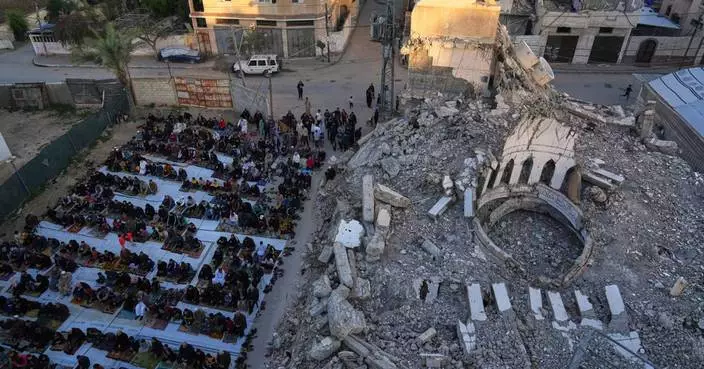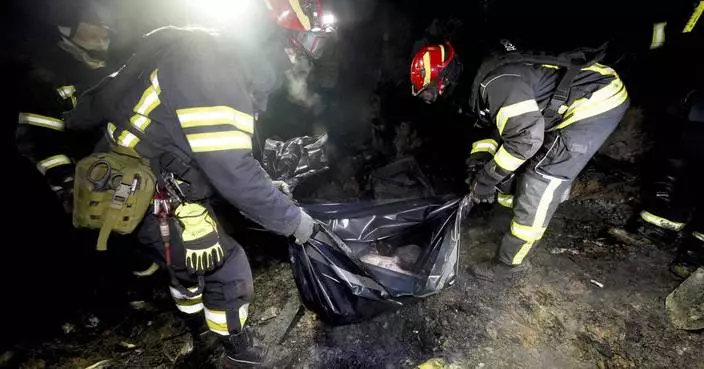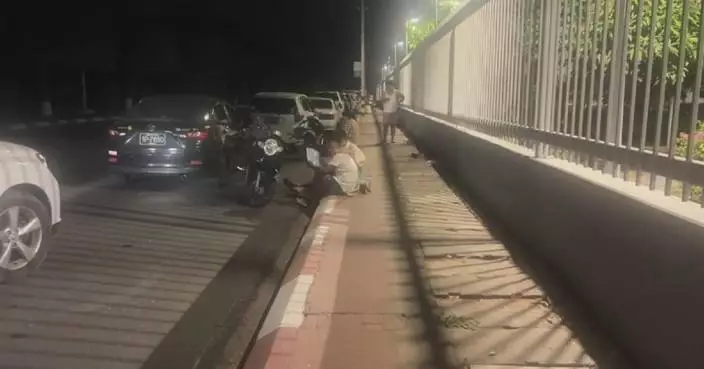CHARLESTON, W.Va. (AP) — Synthetic dyes used to make brightly colored cereals, drinks and candies are coming under scrutiny in states across the country, where lawmakers say the federal government has stalled in taking action despite evidence of harmful effects.
West Virginia, which ranks at the bottom in the U.S. for many health metrics, became the first to sign a sweeping statewide ban on seven such dyes this week. Lawmakers in more than 20 states — from deep red West Virginia to heavily Democratic California — are making a bipartisan push to restrict access to the dyes, which have been tied to neurobehavioral problems in some children and of which U.S. Health and Human Services Secretary Robert F. Kennedy Jr. has been an outspoken critic.
“We should not be forced to police our own foods,” said Republican Sen. Laura Wakim Chapman, who heads the Senate's health committee and told lawmakers the vote might be the most important of their political careers. “No more toxic colors, no more poisoning ourselves and our children. No more unnecessary risks. Our health is not for sale."
In signing the bill, Republican Gov. Patrick Morrisey referenced Kennedy's slogan in saying, “There’s no better place to lead the Make America Healthy Again mission."
The prohibition on certain preservatives and red, blue, green and yellow dyes takes effect for school food in August, and across the state in 2028. It follows narrower bills approved in California last year and Virginia last week that would ban six artificial dyes from being served in public schools beginning in 2027.
Thirty-six color additives are approved by the Federal Drug Administration for use in food and drinks in the U.S. Nine petroleum-based chemical dyes, including Red 3, have been allowed in U.S. food.
Public health advocates have been lobbying for state and federal action for years, pointing to research that links food dyes and other chemical additives to health risks, including exacerbating symptoms of attention-deficit/hyperactivity disorder in some children and animal research linking certain additives to cancers.
The European Union and some countries, including Australia and Japan, have banned or restricted the use of certain food dyes because of potential health risks.
In October, dozens of protesters outside the Michigan headquarters of WK Kellogg Co. demanded that the company remove artificial dyes from cereals such as Apple Jacks and Froot Loops. Kellogg announced that it would remove artificial colors and ingredients from its U.S. products by 2018, but never did so, despite making the change in other countries, such as Canada, where Froot Loops are colored with concentrated carrot juice, watermelon juice and blueberry juice.
The U.S. Food and Drug Administration banned Red 3 from the nation’s food supply in January, setting a 2027 deadline for manufacturers to eliminate it from their products. Makers of ingested drugs like cough syrups have until January 2028.
The National Confectioners Association, a trade group for chocolate, candy, gum and mints sellers, said the new regulations will make food more expensive, less accessible and lead to less variety on grocery store shelves. It said states such as West Virginia, where 1 in 4 children live in poverty and many neighborhoods are “food deserts” with limited access to affordable, nutritious food, will be disproportionately impacted.
Charles Leftwich, vice president of food safety and quality assurance for Sysco Corp., the world’s largest food service distributor, said food safety policies should be supported by science and “be consistently applied across all geographies.”
“We shouldn’t have a fragmented approach when it comes to food safety, because it breeds a lack of trust and confidence with within consumers,” Leftwich said in an interview with The Associated Press.
School districts in West Virginia have begun phasing out breakfast cereals, strawberry milk or other products in anticipation of the new law's August deadline.
Chris Derico, who runs Harrison County's school nutrition program, expects the new regulation to increase costs but said he's not “in panic mode about it” because none of the products containing the artificial dyes are used in main dishes served to students.
Travis Austin, who leads food service in the Cabell County Schools system, called the policy “a step in the right direction” and said it will be up to manufacturers to rework their formulas to remain competitive.
“It’s all about money,” he said. “If Froot Loops and Lucky Charms aren’t going to change their formulations, then we’re not going to buy them. We’ll buy ones that do.”
Lawmakers in West Virginia, which leads the nation in chronic diseases such as obesity, noted that the dyes are often found in sugary foods.
When the bill passed the state Senate, sponsor Jason Barrett said West Virginia was the first state to approve such a sweeping law but won’t be the last. He cited a bill advancing in Oklahoma that would ban 21 synthetic food dyes and additives.
He said companies prey on low-income consumers and children.
“With passage of this bill, we are saying to big food corporations that the health of our people comes first,” he said.

FILE - West Virginia Attorney General Patrick Morrisey speaks during a news conference at the state Capitol, in Charleston, W.Va., May 4, 2023. (AP Photo/Jeff Dean, File)

FILE - Robert F. Kennedy, Jr., President Trump's nominee to serve as Secretary of Health and Human Services testifies during a Senate Committee on Health, Education, Labor and Pensions hearing for his pending confirmation on Capitol Hill, Thursday, Jan. 30, 2025, in Washington. (AP Photo/Rod Lamkey, Jr., File)
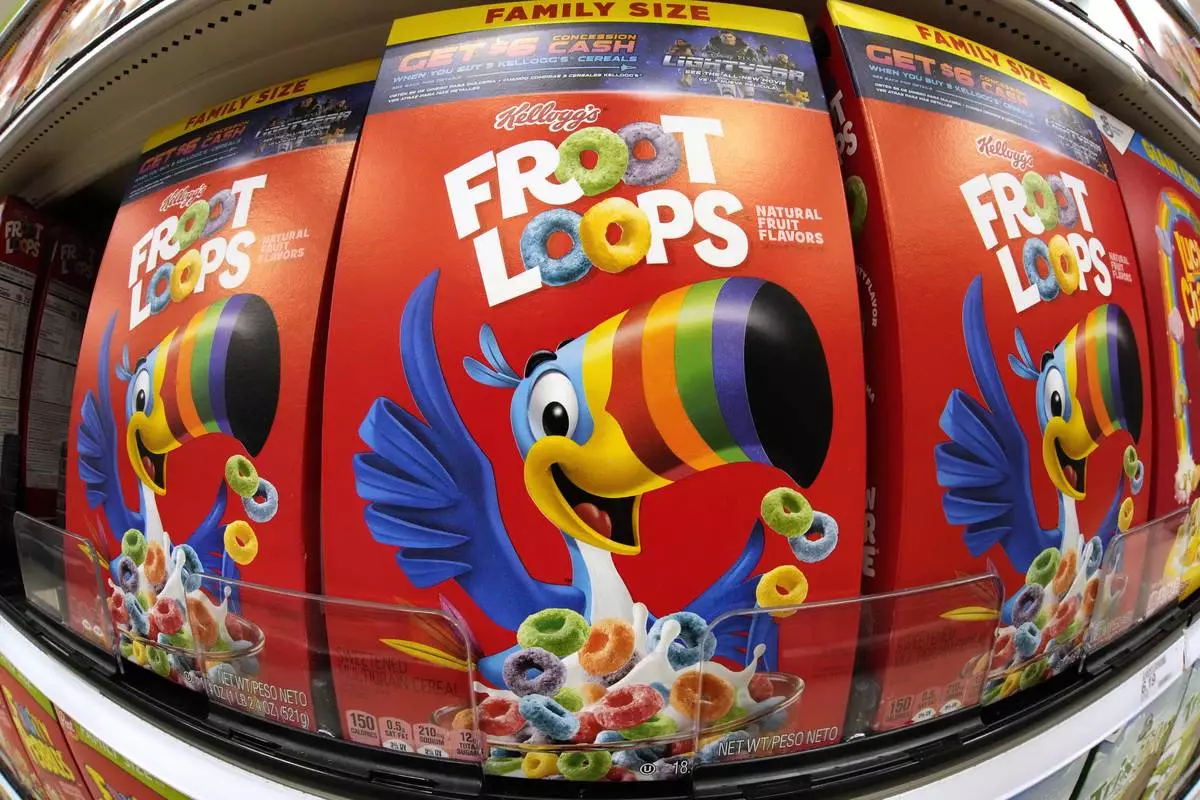
FILE - Boxes of Kellogg's Fruit Loops cereal are displayed in a Target store in Pittsburgh, Nov. 16, 2022. (AP Photo/Gene J. Puskar, File)
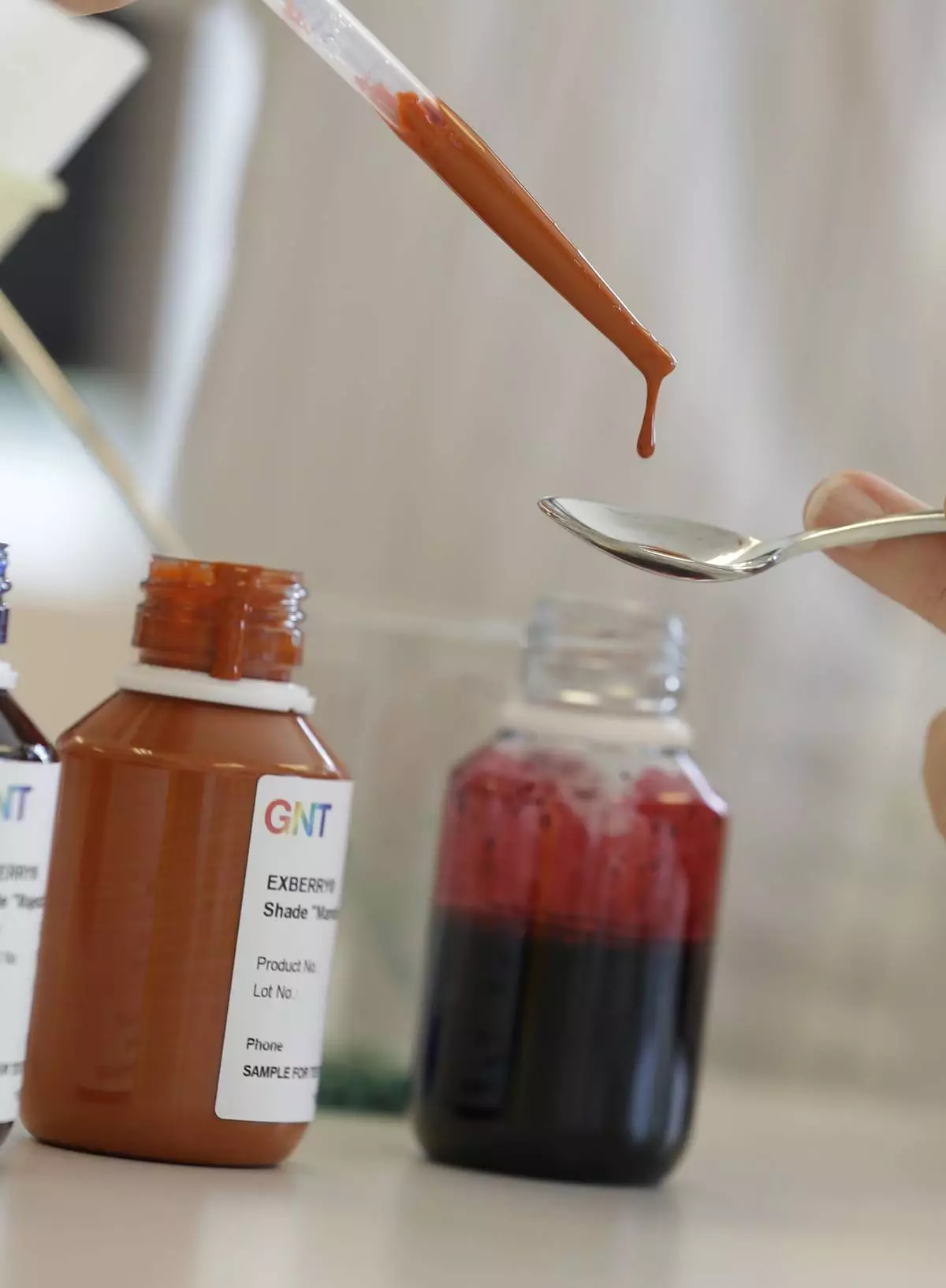
FILE - In this photo from July 29, 2015, a GNT employee deposits carrot extract on to a spoon at their offices in Tarrytown, N.Y. (AP Photo/Seth Wenig, File)
DEIR AL-BALAH, Gaza Strip (AP) — Gaza’s bakeries will run out of flour for bread within a week, the U.N. says. Agencies have cut food distributions to families in half. Markets are empty of most vegetables. Many aid workers cannot move around because of Israeli bombardment.
For four weeks, Israel has shut off all sources of food, fuel, medicine and other supplies for the Gaza Strip’s population of more than 2 million Palestinians. It’s the longest blockade yet of Israel’s 17-month-old campaign against Hamas, with no sign of it ending. Many are going hungry during the normally festive Eid al-Fitr, a major Muslim holiday.
Aid workers are stretching out the supplies they have but warn of a catastrophic surge in severe hunger and malnutrition. Eventually, food will run out completely if the flow of aid is not restored, because the war has destroyed almost all local food production in Gaza.
“We depend entirely on this aid box,” said Shorouq Shamlakh, a mother of three collecting her family’s monthly box of food from a U.N. distribution center in Jabaliya in northern Gaza. She and her children reduce their meals to make it last a month, she said. “If this closes, who else will provide us with food?”
The World Food Program said Thursday that its flour for bakeries is only enough to keep producing bread for 800,000 people a day until Tuesday and that its overall food supplies will last a maximum of two weeks. As a “last resort” once all other food is exhausted, it has emergency stocks of fortified nutritional biscuits for 415,000 people.
Fuel and medicine will last weeks longer before hitting zero. Hospitals are rationing antibiotics and painkillers. Aid groups are shifting limited fuel supplies between multiple needs, all indispensable — trucks to move aid, bakeries to make bread, wells and desalination plants to produce water, hospitals to keep machines running.
“We have to make impossible choices. Everything is needed,” said Clémence Lagouardat, the Gaza response leader for Oxfam International, speaking from Deir al-Balah in central Gaza at a briefing Wednesday. “It’s extremely hard to prioritize.”
Compounding the problems, Israel resumed its military campaign on March 18 with bombardment that has killed hundreds of Palestinians, mostly women and children, according to health officials. It has hit humanitarian facilities, the U.N. says. New evacuation orders have forced more than 140,000 Palestinians to move yet again.
But Israel has not resumed the system for aid groups to notify the military of their movements to ensure they were not hit by bombardment, multiple aid workers said. As a result, various groups have stopped water deliveries, nutrition for malnourished children and other programs because it's not safe for teams to move.
COGAT, the Israeli military body in charge of coordinating aid, said the system was halted during the ceasefire. Now it is implemented in some areas “in accordance with policy and operational assessments ... based on the situation on the ground,” COGAT said, without elaborating.
During the 42 days of ceasefire that began in mid-January, aid groups rushed in significant amounts of aid. Food also streamed into commercial markets.
But nothing has entered Gaza since Israel cut off that flow on March 2. Israel says the siege and renewed military campaign aim to force Hamas to accept changes in their agreed-on ceasefire deal and release more hostages.
Fresh produce is now rare in Gaza’s markets. Meat, chicken, potatoes, yogurt, eggs and fruits are completely gone, Palestinians say.
Prices for everything else have skyrocketed out of reach for many Palestinians. A kilo (2 pounds) of onions can cost the equivalent of $14, a kilo of tomatoes goes for $6, if they can be found. Cooking gas prices have spiraled as much as 30-fold, so families are back to scrounging for wood to make fires.
“It’s totally insane,” said Abeer al-Aker, a teacher and mother of three in Gaza City. “No food, no services. … I believe that the famine has started again. ”
At the distribution center in Jabaliya, Rema Megat sorted through the food ration box for her family of 10: rice, lentils, a few cans of sardines, a half kilo of sugar, two packets of powdered milk.
“It’s not enough to last a month,” she said. “This kilo of rice will be used up in one go.”
The U.N. has cut its distribution of food rations in half to redirect more supplies to bakeries and free kitchens producing prepared meals, said Olga Cherevko, spokesperson for the U.N. humanitarian agency, known as OCHA.
The number of prepared meals has grown 25% to 940,000 meals a day, she said, and bakeries are churning out more bread. But that burns through supplies faster.
Once flour runs out soon, “there will be no bread production happening in a large part of Gaza,” said Gavin Kelleher, with the Norwegian Refugee Council.
UNRWA, the main U.N. agency for Palestinians, only has a few thousand food parcels left and enough flour for a few days, said Sam Rose, the agency's acting director in Gaza.
Gaza Soup Kitchen, one of the main public kitchens, can’t get any meat or much produce, so they serve rice with canned vegetables, co-founder Hani Almadhoun said.
“There are a lot more people showing up, and they’re more desperate. So people are fighting for food,” he said.
The United States pressured Israel to let aid into Gaza at the beginning of the war in October 2023, after Israel imposed a blockade of about two weeks. This time, it has supported Israel’s policy.
Rights groups have called it a “starvation policy” that could be a war crime.
Israeli Foreign Minister Gideon Saar told a news conference Monday that “Israel is acting in accordance with international law.”
He accused Hamas of stealing aid and said Israel is not required to let in supplies if it will be diverted to combatants.
He gave no indication of whether the siege could be lifted but said Gaza had enough supplies, pointing to the aid that flowed in during the ceasefire.
Because its teams can’t coordinate movements with the military, Save the Children suspended programs providing nutrition to malnourished children, said Rachael Cummings, the group’s humanitarian response leader in Gaza.
“We are expecting an increase in the rate of malnutrition,” she said. “Not only children — adolescent girls, pregnant women.”
During the ceasefire, Save the Children was able to bring some 4,000 malnourished infants and children back to normal weight, said Alexandra Saif, the group’s head of humanitarian policy.
About 300 malnourished patients a day were coming into its clinic in Deir al-Balah, she said. The numbers have plunged — to zero on some days — because patients are too afraid of bombardment, she said.
The multiple crises are intertwined. Malnutrition leaves kids vulnerable to pneumonia, diarrhea and other diseases. Lack of clean water and crowded conditions only spread more illnesses. Hospitals overwhelmed with the wounded can’t use their limited supplies on other patients.
Aid workers say not only Palestinians, but their own staff have begun to fall into despair.
“The world has lost its compass,” UNRWA’s Rose said. “There’s just a feeling here that anything could happen, and it still wouldn’t be enough for the world to say, this is enough.”
Magdy and Keath reported from Cairo, El Deeb from Beirut. AP correspondents Fatma Khaled in Cairo and Julia Frankel and Sam Mednick in Jerusalem contributed.

Muslim worshippers offer Eid al-Fitr prayer in the mixed Arab Jewish city of Jaffa, near Tel Aviv, Israel, Sunday, March 30, 2025. (AP Photo/Ohad Zwigenberg)
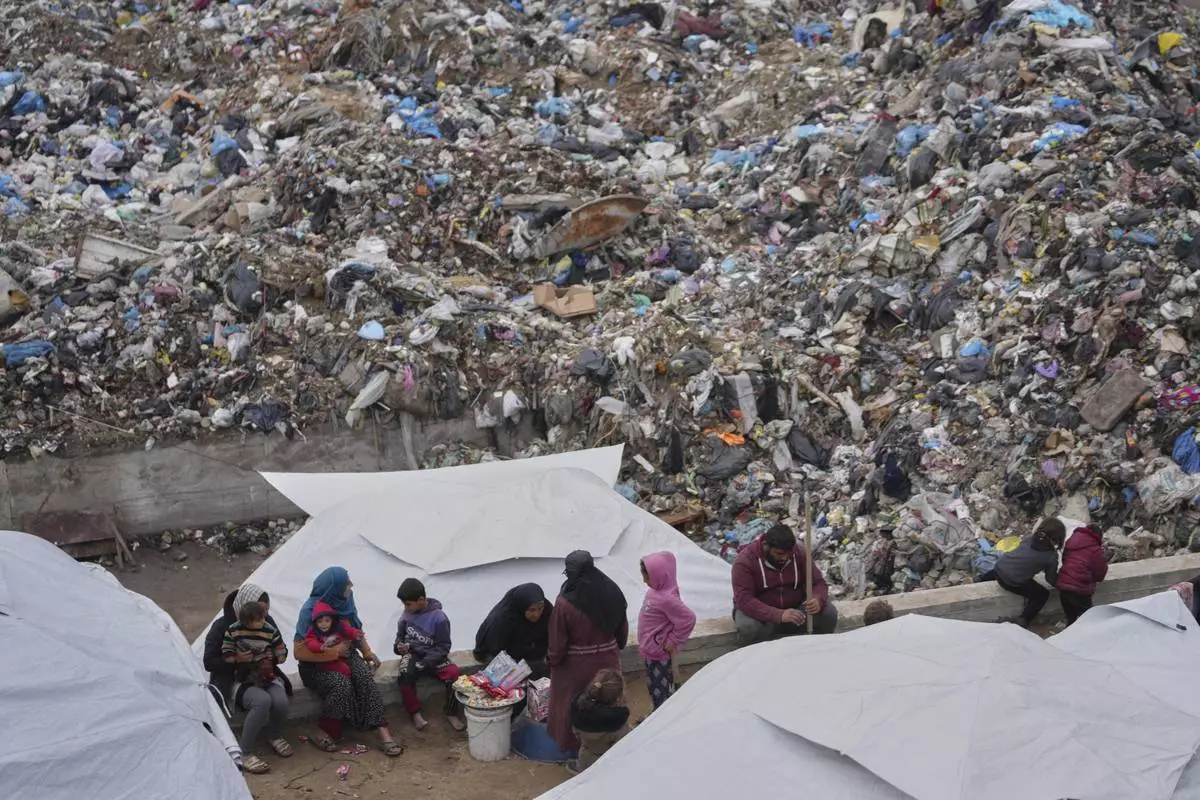
Palestinians displaced by the Israeli air and ground offensive on the Gaza Strip sit in a makeshift tent camp inside a landfill in central Gaza Strip, Friday, March 21, 2025. (AP Photo/Jehad Alshrafi)
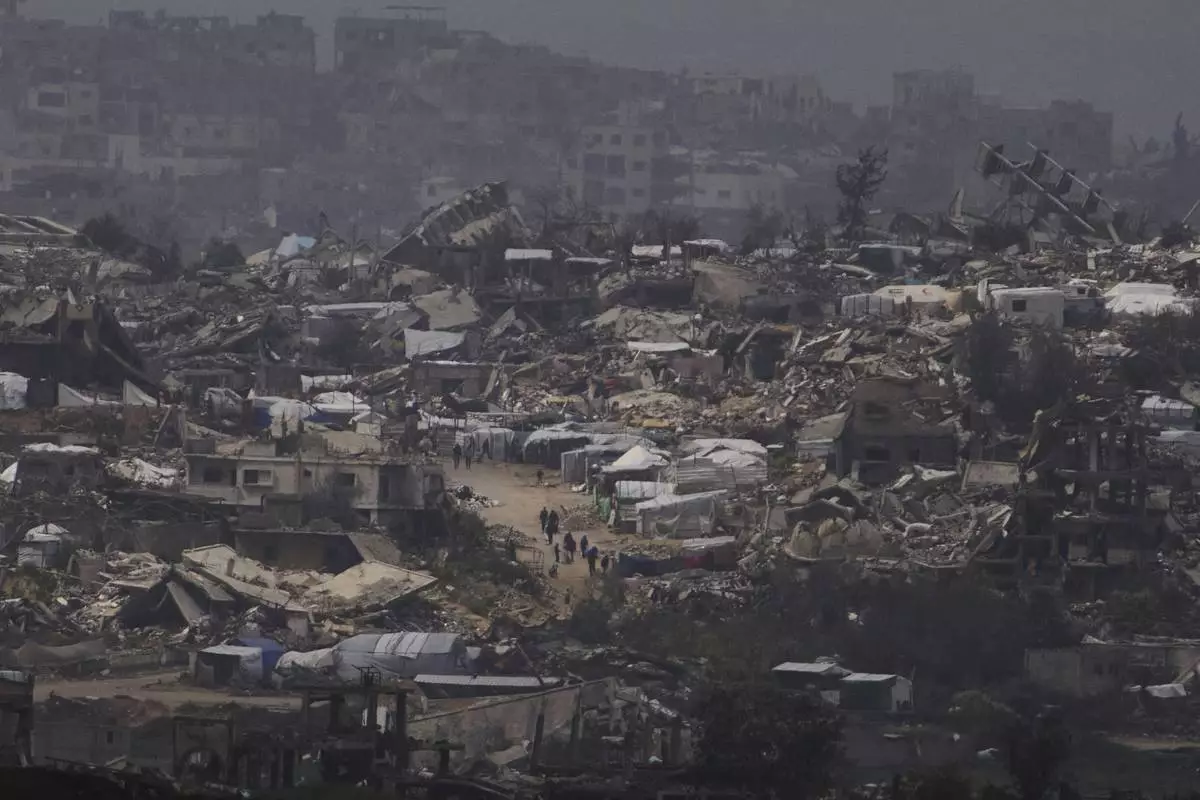
People walking surrounded by buildings destroyed during the Israeli air and ground offensive in the Gaza Strip are seen from southern Israel, Thursday, March 20, 2025. (AP Photo/Leo Correa)
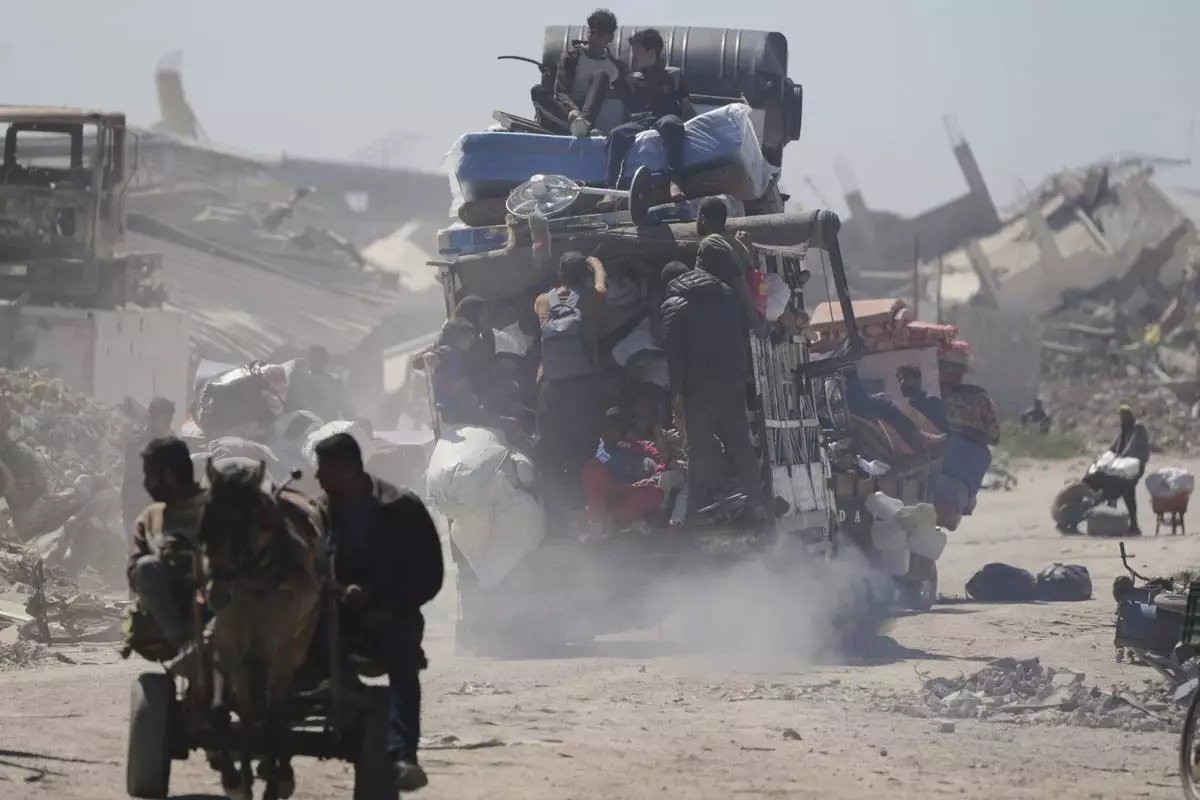
Displaced Palestinians, carrying their belongings traveling from Beit Hanoun to Jabaliya, a day after Israel's renewed offensive in the Gaza Strip, Wednesday, March 19, 2025. (AP Photo/Jehad Alshrafi)
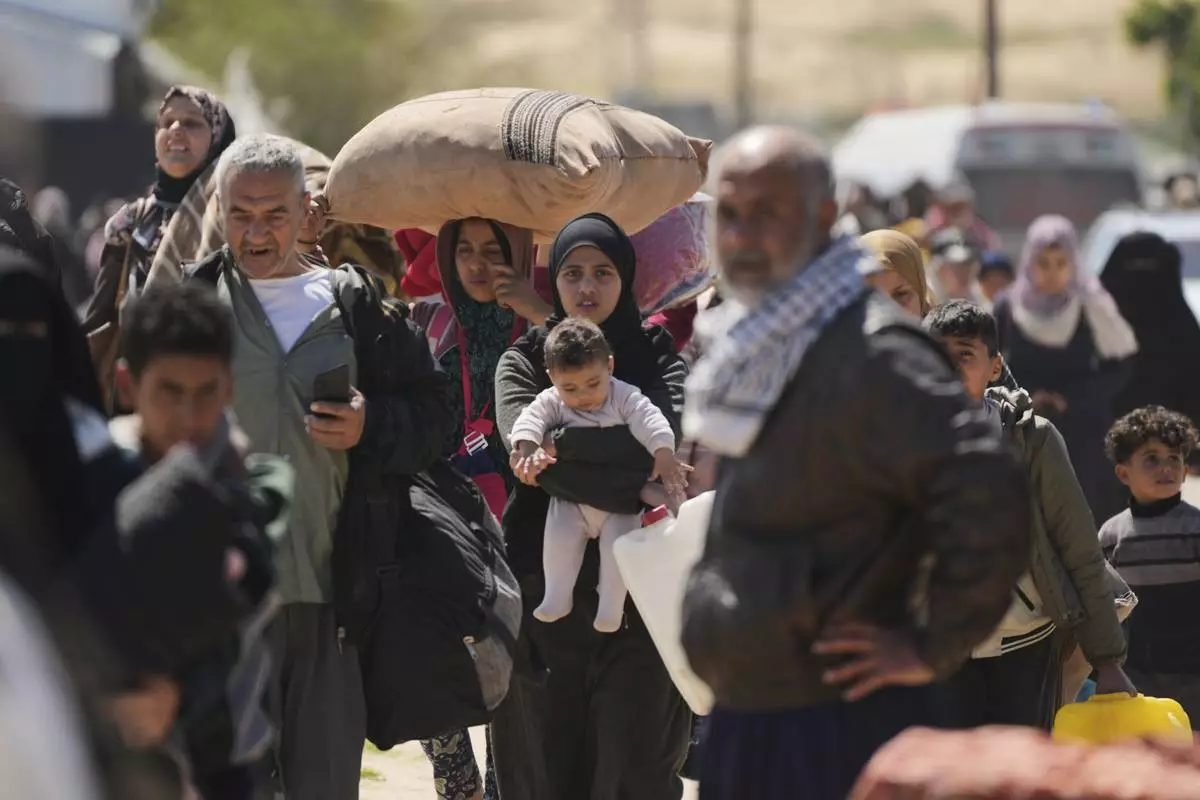
Displaced Palestinians, who flee from Rafah amidst ongoing Israeli military operations following Israel's renewed offensive in the Gaza Strip, arrive in Khan Younis, Gaza, on Sunday, March 23, 2025. (AP Photo/Abdel Kareem Hana)
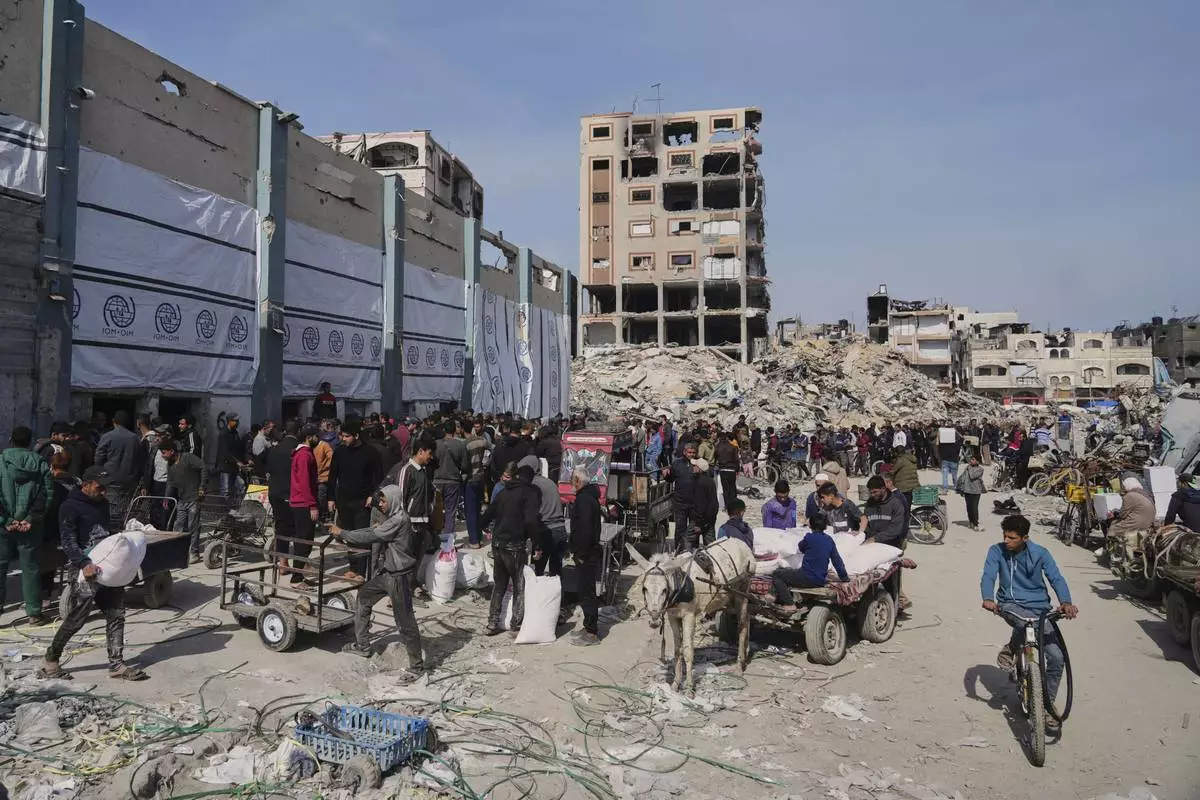
Palestinians receive bags of flour and other humanitarian aid distributed by UNRWA, the U.N. agency helping Palestinian refugees in Jabaliya, Gaza Strip on Tuesday, March 25, 2025. (AP Photo/Jehad Alshrafi)
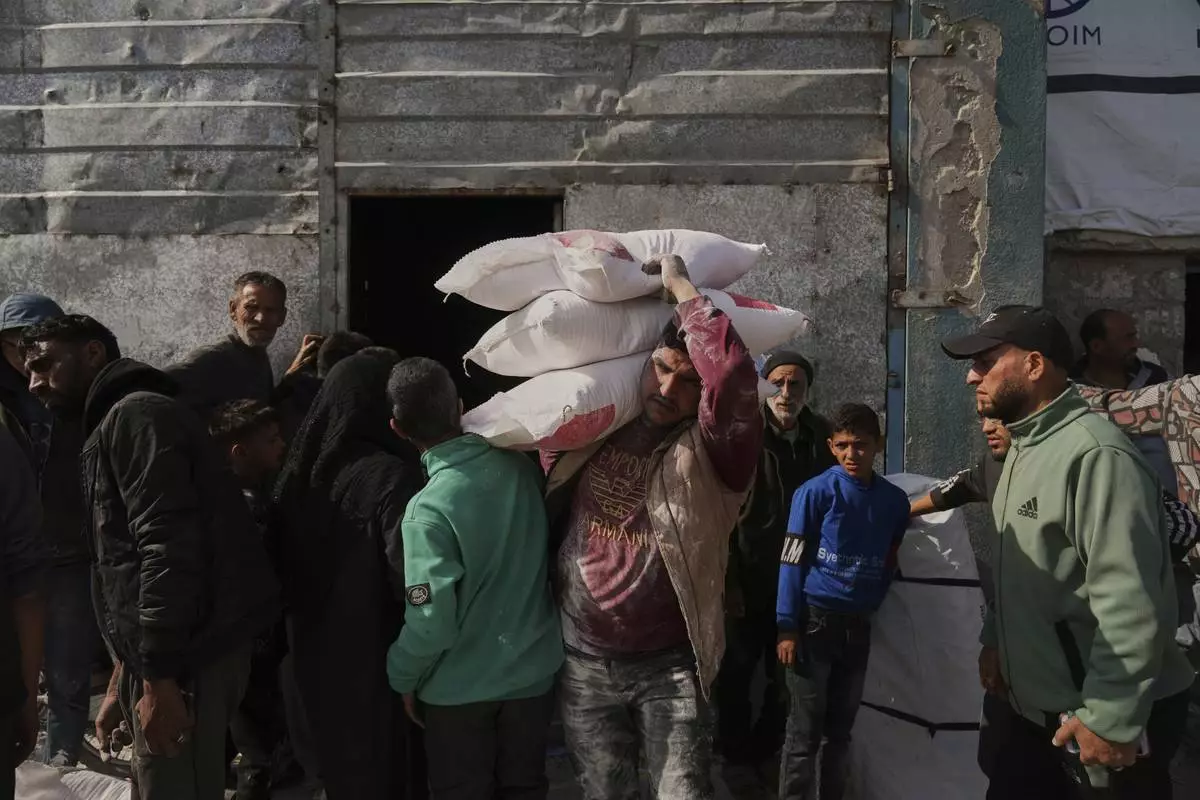
Palestinians receive bags of flour and other humanitarian aid distributed by UNRWA, the U.N. agency helping Palestinian refugees in Jabaliya, Gaza Strip on Tuesday, March 25, 2025. (AP Photo/Jehad Alshrafi)
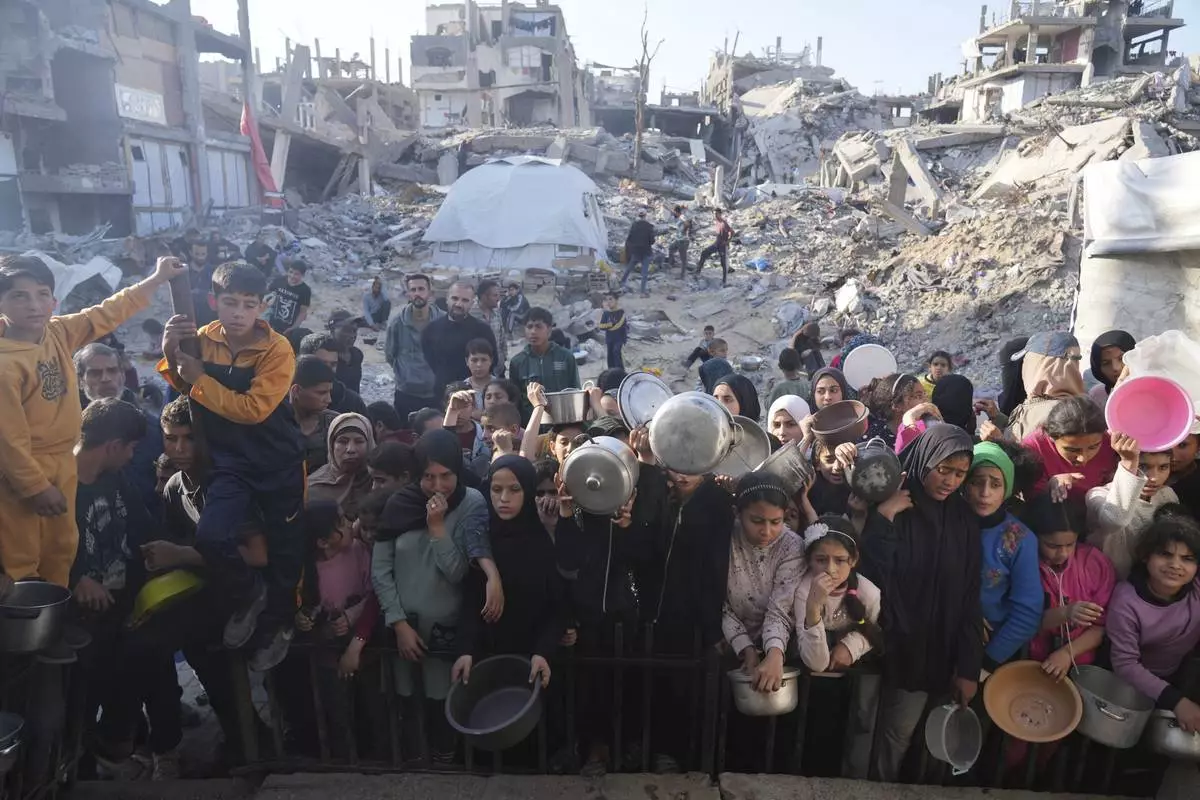
Palestinian wait get donated food at a distribution center in Beit Lahiya, northern Gaza Strip, Sunday, March 16, 2025. (AP Photo/Abdel Kareem Hana)
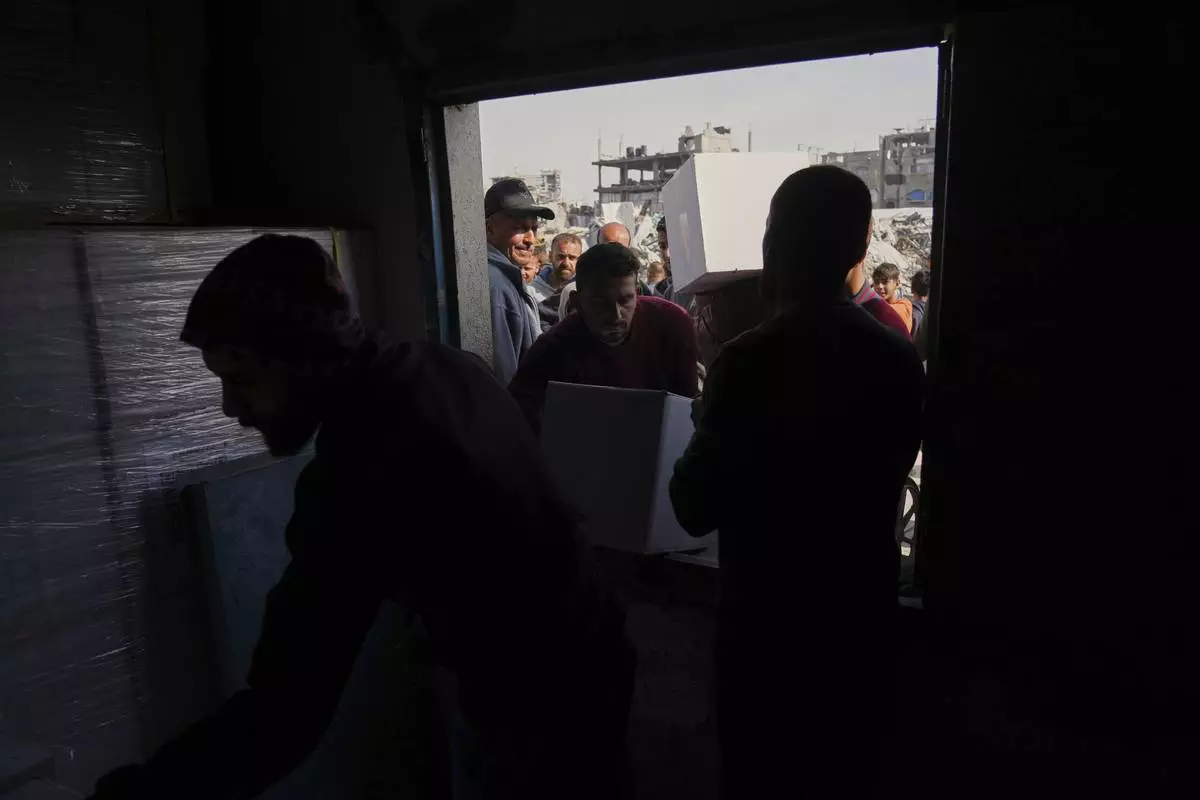
Palestinians receive bags of flour and other humanitarian aid distributed by UNRWA, the U.N. agency helping Palestinian refugees in Jabaliya, Gaza Strip on Tuesday, March 25, 2025. (AP Photo/Jehad Alshrafi)
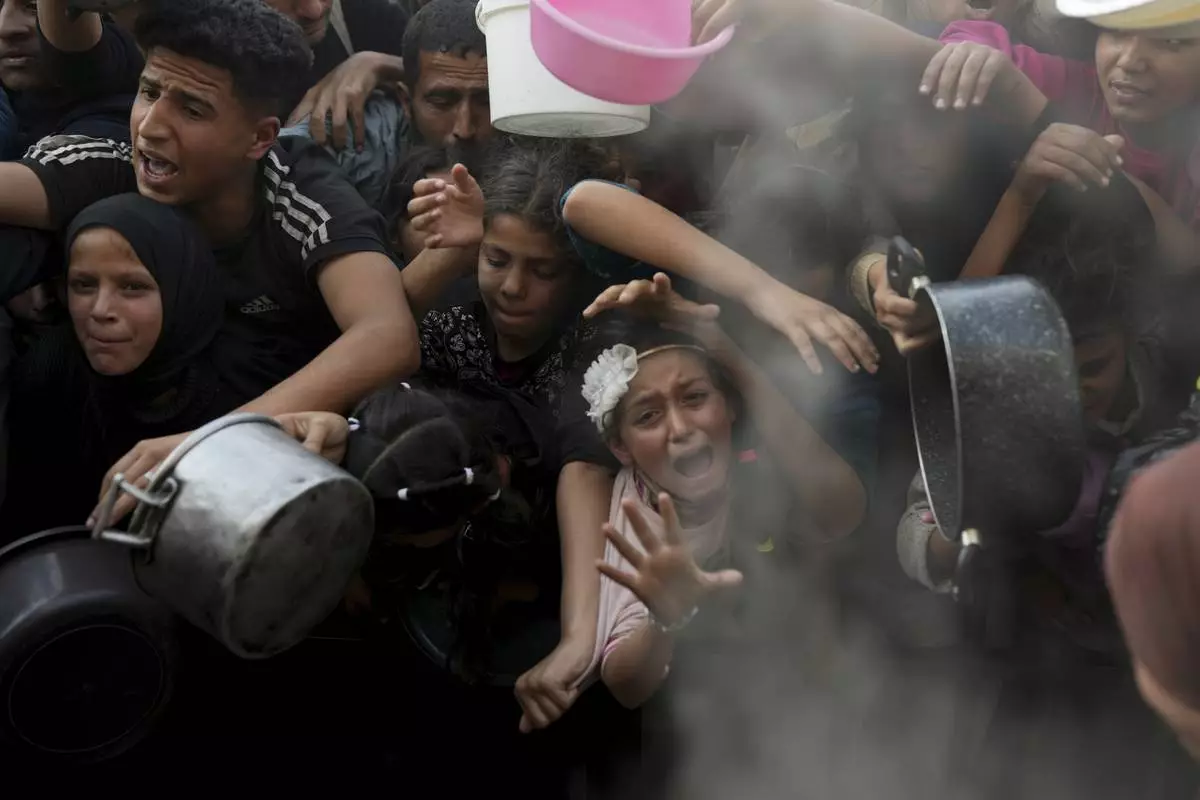
A Palestinian girl struggles as she and others try to get donated food at a distribution center in Beit Lahiya, northern Gaza Strip, Sunday, March 16, 2025. (AP Photo/Abdel Kareem Hana)






